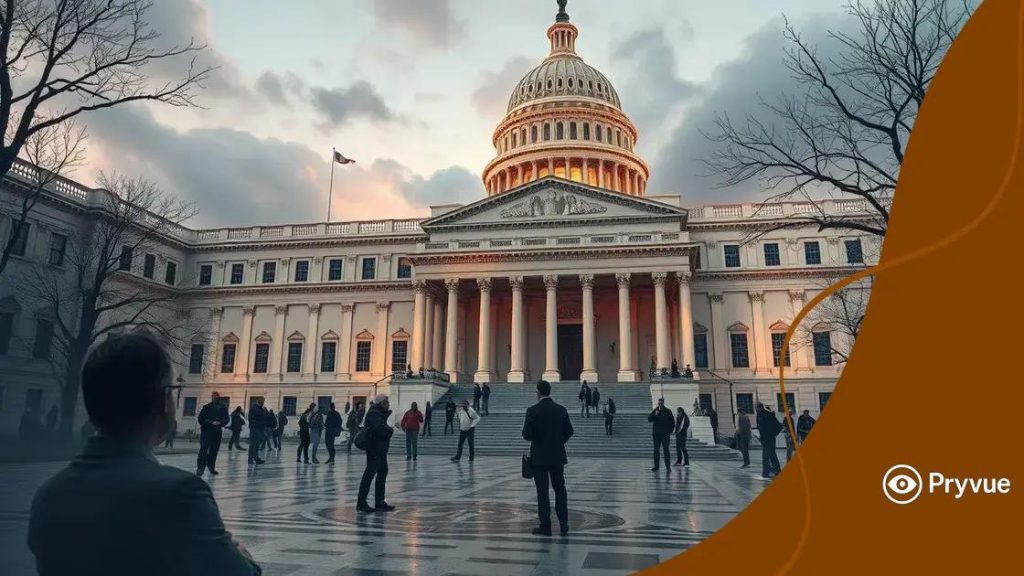Policies of the current US government: what to know

Anúncios
The future directions for US policy-making will emphasize sustainability, healthcare innovations, technological advancements, and inclusive governance to effectively address the evolving needs of society.
Policies of the current US government significantly influence various aspects of our lives. Have you ever wondered how these decisions shape your community and the nation? Let’s delve into their implications.
Anúncios
Overview of current US government policies
The current US government policies are designed to address a wide range of issues that affect citizens directly. By understanding these policies, you can better grasp how they impact your daily life and society.
Key Areas of Focus
Several critical areas define the landscape of these policies. They are aimed at enhancing national security, improving healthcare, and addressing climate change. Each of these areas plays a significant role in shaping public response.
National Security Policies
National security is a top priority for the government. Initiatives often include counter-terrorism measures, border security, and military funding. With growing global tensions, these policies are becoming increasingly crucial.
Anúncios
- Investing in cybersecurity to protect citizens’ data.
- Enhancing surveillance at key transportation hubs.
- Strengthening military alliances with global partners.
These efforts not only aim to safeguard the country but also to foster international collaborations that can prevent conflicts.
Healthcare Initiatives
Healthcare remains a significant concern for many Americans. The aim is to provide better access to services and improve overall public health. Government actions include expanding Medicaid and ensuring health insurance coverage for more citizens.
By focusing on preventative care, these policies attempt to reduce long-term healthcare costs for communities.
Climate Change Policies
As climate change drives more extreme weather events, responses are gaining urgency. Current policies focus on promoting renewable energy, reducing carbon emissions, and protecting natural resources. These steps are vital for sustainability and public health.
- Incentives for using solar and wind energy.
- Regulations to limit emissions from factories.
- Investment in public transportation to cut down pollution.
Such measures not only aim to ensure a healthier environment but also create jobs in emerging green sectors, demonstrating a commitment to sustainable growth.
Key areas of focus in government strategies
One of the most important aspects of the current US government policies is identifying the key areas of focus in government strategies. Understanding these areas helps us see how decisions are made and their effects on everyday life.
Economic Growth
Economic growth is a primary focus for the government. Policies aimed at stimulating the economy can create jobs and improve living standards. The government emphasizes innovation and support for small businesses as essential elements of economic strategy.
- Tax incentives for startups and small businesses.
- Investment in infrastructure projects to create jobs.
- Support for technology and green initiatives to boost future growth.
These initiatives can have a long-term impact on job creation and overall economic stability.
Social Justice and Equity
An essential area for government strategies is promoting social justice and equity. This involves addressing systemic inequalities that affect various communities. The government seeks to ensure fair treatment and access to resources for all citizens.
Efforts in this area include advancing civil rights, improving access to education, and enhancing economic opportunities for underserved populations.
Healthcare Access
Access to healthcare is another critical focus. The government aims to provide affordable and comprehensive healthcare services to all citizens. This includes measures to expand Medicaid and develop programs to reduce prescription drug costs.
By improving access, the government helps promote a healthier population and reduce long-term healthcare costs for everyone.
Environmental Protection
Environmental protection is increasingly a priority. Government strategies focus on combating climate change and conserving natural resources. This includes promoting renewable energy sources and implementing regulations to reduce pollution.
- Encouragement of public transportation to decrease carbon footprints.
- Regulations for cleaner air and water.
- Incentives for businesses that adopt sustainable practices.
These measures reflect a commitment to protecting the planet and ensuring a sustainable future for generations to come.
Impact of policies on the economy

The impact of policies on the economy can be profound. Government decisions shape the economic landscape, influencing growth, employment, and stability. Understanding these impacts helps us navigate our financial futures.
Job Creation and Unemployment Rates
One of the most direct impacts of government policy is on job creation. Policies that encourage business investments lead to more job opportunities. For example, tax cuts can incentivize companies to expand, thereby hiring more workers.
- Increased funding for infrastructure can create thousands of construction jobs.
- Support for small businesses often results in local job creation.
- Training programs funded by the government can help unemployed workers gain new skills.
These initiatives not only help lower unemployment rates but also boost overall economic confidence.
Inflation Control
Government policies also play a crucial role in controlling inflation. By adjusting interest rates and influencing monetary supply, the government can help stabilize prices. When inflation is high, it erodes purchasing power, making it vital for policies to address this issue.
Strategies to control inflation often include reducing government spending or increasing interest rates, both of which aim to prevent an overheated economy.
Investment in Public Services
Another important aspect is the investment in public services. Government policies that fund education, healthcare, and public transportation can strengthen the economy in the long run. Quality public services contribute to a healthier, more educated workforce.
This, in turn, fosters innovation and productivity, which are essential for sustained economic growth.
Economic Inequality
Finally, the impact of policies on economic inequality is significant. Targeted measures such as social safety nets, minimum wage laws, and progressive taxation aim to reduce disparities in wealth and income. By addressing these inequalities, policies can lead to a more balanced economy.
- Universal basic income proposals are being discussed to help support low-income individuals.
- Investment in affordable housing can provide stability for families.
- Educational grants can help lower-income students access higher education.
When economic disparity is minimized, overall economic health improves, benefiting society as a whole.
Public opinion and government policies
Public opinion plays a vital role in shaping government policies. Policymakers often listen to the voices of the people to ensure their decisions reflect the needs and desires of constituents. Understanding this relationship is key to appreciating how policies are developed.
Influence of Polls and Surveys
Polls and surveys are common tools used to gauge public opinion. They provide insights into what citizens think about various issues, from healthcare to education reforms. When the results show strong support or opposition, governments tend to respond accordingly.
- Surveys can reveal trends over time, helping officials identify rising concerns.
- Results can affect campaign strategies for politicians seeking election.
- Information from polls often leads to policy adjustments based on public demand.
This data helps leaders align their actions with the preferences of the electorate.
Media’s Role
The media serves as a crucial bridge between the government and the public. Through news coverage, social media, and opinion pieces, they inform citizens and influence their views on policies. Positive or negative coverage can sway public sentiment significantly.
When a policy gains media attention, it can create a wave of public support or backlash, prompting government officials to respond to these shifts.
Civic Engagement and Activism
Civic engagement through activism also shapes policies. Grassroots movements and campaigns often advocate for changes in legislation. When citizens unite for a common cause, their collective voice can lead to significant policy changes.
- Community rallies and protests raise awareness about key issues.
- Petitions can mobilize support for specific policy shifts.
- Engagement in local government meetings allows citizens to directly voice their concerns.
These activities showcase the power of public opinion as a driving force behind policy changes.
Feedback Mechanisms
Governments also implement feedback mechanisms to hear directly from the public. Town hall meetings, focus groups, and online forums allow citizens to express their views on existing policies. This feedback can highlight areas needing improvement.
By actively seeking input, policymakers demonstrate their commitment to listening and adapting to the changing needs of their communities.
Future directions for US policy-making
The future directions for US policy-making are shaped by current trends and emerging challenges. As society evolves, so do the priorities and strategies of the government. Understanding these directions helps us anticipate the changes that may come.
Emphasis on Sustainability
One important focus in the future of policy-making is sustainability. Policymakers are increasingly aware of the impact of climate change and are pushing for more environmentally friendly practices. Efforts to promote renewable energy and reduce carbon emissions are central to this goal.
- Incentives for electric vehicles and sustainable transportation.
- Funding for research and development in clean energy technologies.
- Regulations aimed at reducing waste and encouraging recycling.
Investments in sustainability not only address environmental concerns but also create job opportunities in green industries.
Healthcare Innovations
The future of US policy-making will also focus on healthcare innovations. The COVID-19 pandemic highlighted the need for resilient healthcare systems. Therefore, efforts are underway to improve healthcare accessibility and affordability.
Expanding telehealth services and investing in public health infrastructure will ensure better preparedness for future health crises.
Technological Advancements
As technology continues to evolve, it will play a significant role in shaping policies. The government is increasingly looking at how technology can improve services and infrastructure. This includes using data analytics to make informed decisions and increase transparency.
- Implementing smart city initiatives to enhance urban living.
- Integrating artificial intelligence in public service delivery.
- Protecting consumer privacy in the digital landscape.
Policies must adapt to technological changes to remain effective and relevant.
Inclusive Governance
Future policies are likely to emphasize inclusion and representation. Governments are recognizing the importance of engaging diverse voices in the decision-making process. This includes efforts to involve underrepresented communities and ensure their concerns are addressed.
Civic engagement initiatives, such as town halls and online forums, will continue to foster dialogue between officials and the public.
As demographics shift, understanding the needs of a diverse population becomes crucial for effective governance.
FAQ – Frequently Asked Questions about Future Directions in US Policy-Making
What are the key areas of focus for future US policy-making?
Key areas include sustainability, healthcare innovations, technological advancements, and inclusive governance.
How does public opinion influence government policies?
Public opinion shapes policies through polls, surveys, and civic engagement, prompting policymakers to respond to citizens’ concerns.
Why is sustainability important in future policies?
Sustainability helps address climate change, fosters economic growth through green jobs, and ensures a healthier environment for future generations.
What role does technology play in shaping future policies?
Technology improves efficiency in government services and helps in data-driven decision-making, making policies more effective and relevant.